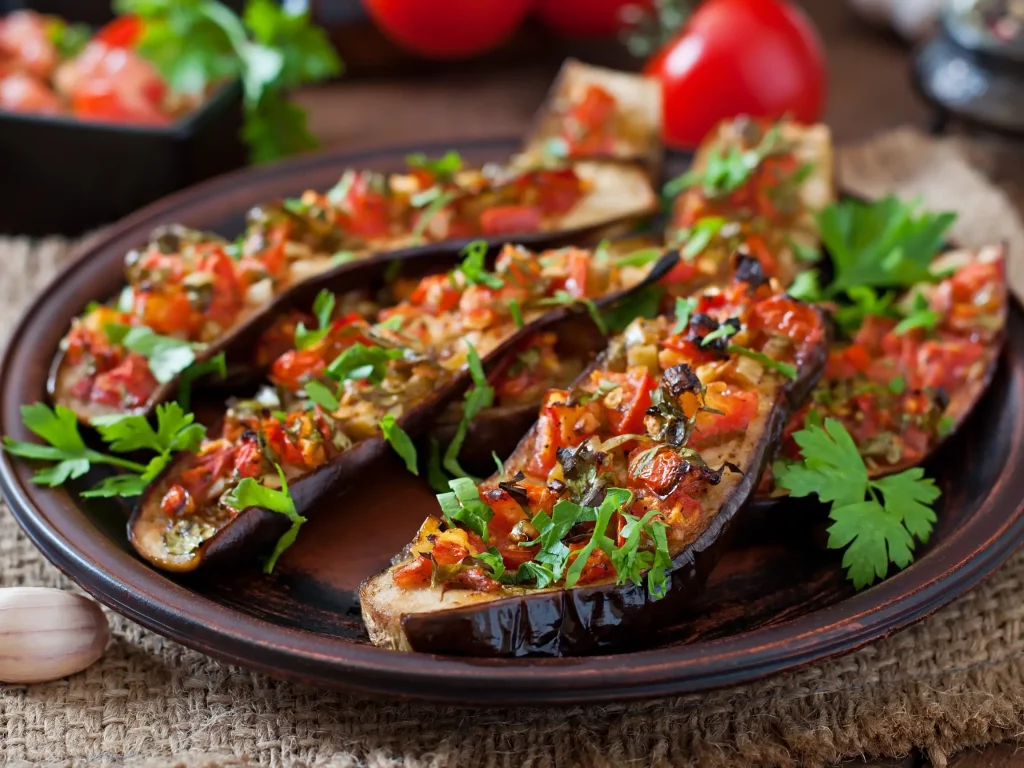Turks love food. They write love songs, ballads and poems about it.
Turkish cuisine produces a great variety of mouthwatering dishes, mostly of Ottoman heritage. In fact, Turkish food is some of the tastiest in the Mediterranean.
Turks have fun with food too!
Some of the names of the dishes are just as colourful and inviting as the food itself.
İmam Bayıldı – The Priest Fainted
One of the most celebrated of all Turkish dishes, İmam Bayıldı (ee-mahm bah-yihl-dih) is a dish of aubergines baked with olive oil, onions, tomatoes, and garlic which can be served hot or cold.

The three legends surrounding the name all involve olive oil. The first version tells, that the imam fainted when he found out that his wife had used an entire bottle of the best – and very expensive – olive oil to prepare the dish.
The second version says that the imam fainted in pure rapture when he tasted the dish for the first time.
The third legend is the imam married the daughter of a rich oil merchant. Part of her dowry were several bottles of the best olive oil. She prepared the stuffed eggplant for the first time and the imam liked it so much that he insisted she make it on a daily basis. After about two weeks, she ran out of olive oil and that’s when the imam fainted in dismay.
Whichever version you want to believe, when ordering Imam bayildi, don’t faint, just enjoy!
Click here for a recipe courtesy of Özlem’s Turkish Table
Hünkar Beğendi – Sultan’s Delight
This eggplant stew is a kind of “creamed” dish so heavenly tasting that the Turkish name means sultan’s delight.

Traditionally, hünkar begendi (hoon–kar bay-endi) is an accompaniment to the spicy lamb stew called tas kebabı.
There are two stories told about how this dish came about. The kitchens of the Ottoman sultans were famed for their culinary creations to please the ruler and this dish was said to have been created for Sultan Murad IV (1623 -1640). Another story attributes the naming of the dish after it had been requested by Empress Eugénie, the wife of Napoleon III, when she visited the Topkapi palace in the mid- nineteenth century.
Click here for a recipe courtesy of Özlem’s Turkish Table
Hoşmerim – “Is it nice, my man?”
Höşmerim (hosh-meh-reem) is a classic Anatolian pudding. Traditional recipes include fresh unsalted cheese (particularly from sheep’s milk), semolina and powdered sugar. It is also known as Hosmelim or cheese halva. It is generally consumed after a meal as a light dessert, alone or combined with ice cream, honey or nuts.

The name of this dessert has an interesting story which occurred during the Ottoman age. In the Ottoman families, wives used to call their husbands “Er” or “Erim”. One woman living in those times didn’t have anything to cook for her husband when he came back from the army. She made up a dessert of home-produced cheese, semolina (irmik) and sugar. She offered this dessert to her husband and asked whether he liked it or not by saying “Hoş mu erim?” meaning “Is it nice, my man?” In time, this has become“Höşmerim”.
Click here for a recipe courtesy of steemit.com
Kadınbudu köfte – Lady’s thigh meatballs
There are theories that this saucy name Kadınbudu köfte (kah-dihn-buh-duh kerf-teh), Lady’s thigh meatballs, was given by the Sultan’s chefs at the Ottoman Palace kitchens. Kadınbudu köfte being a favorite of the Sultans, makes one wonder about inspiration from the Harem!

This tender, juicy kofte has cooked rice in it rather than stale bread and has a delicious coating of beaten eggs and flour. The cooked rice adds a nice texture and a delicious, moist flavor, combined with cumin, red pepper flakes and onions.
Click here for a recipe courtesy of Whats4eat
Kocakarı Gerdanı – Old Woman’s Neck
A dessert pastry of yoghurt and hazelnuts topped with sweetened lemon syrup, rolled and wound in a spiral inside the cooking pan.

Keep an eye out for these colourfully named dishes next time you’re eating out.
Sweet Song
As we mentioned, Turks even write songs about food. Next time you reach the dessert course, ask a Turk to sing this folk song for you:
Haydi güzelim tatlı yitelim Tatlı Tatlı yiyelim Tatlı anlaşalım, şeker ezelim, Hadi güzelim Tatlı Tatlı Tatlı Let’s go eat sweets, my lovely Let’s eat sweets, eat sweets, Let’s understand each other well Let’s go, my lovely Sweets, sweets, sweets
Afiyet olsun








